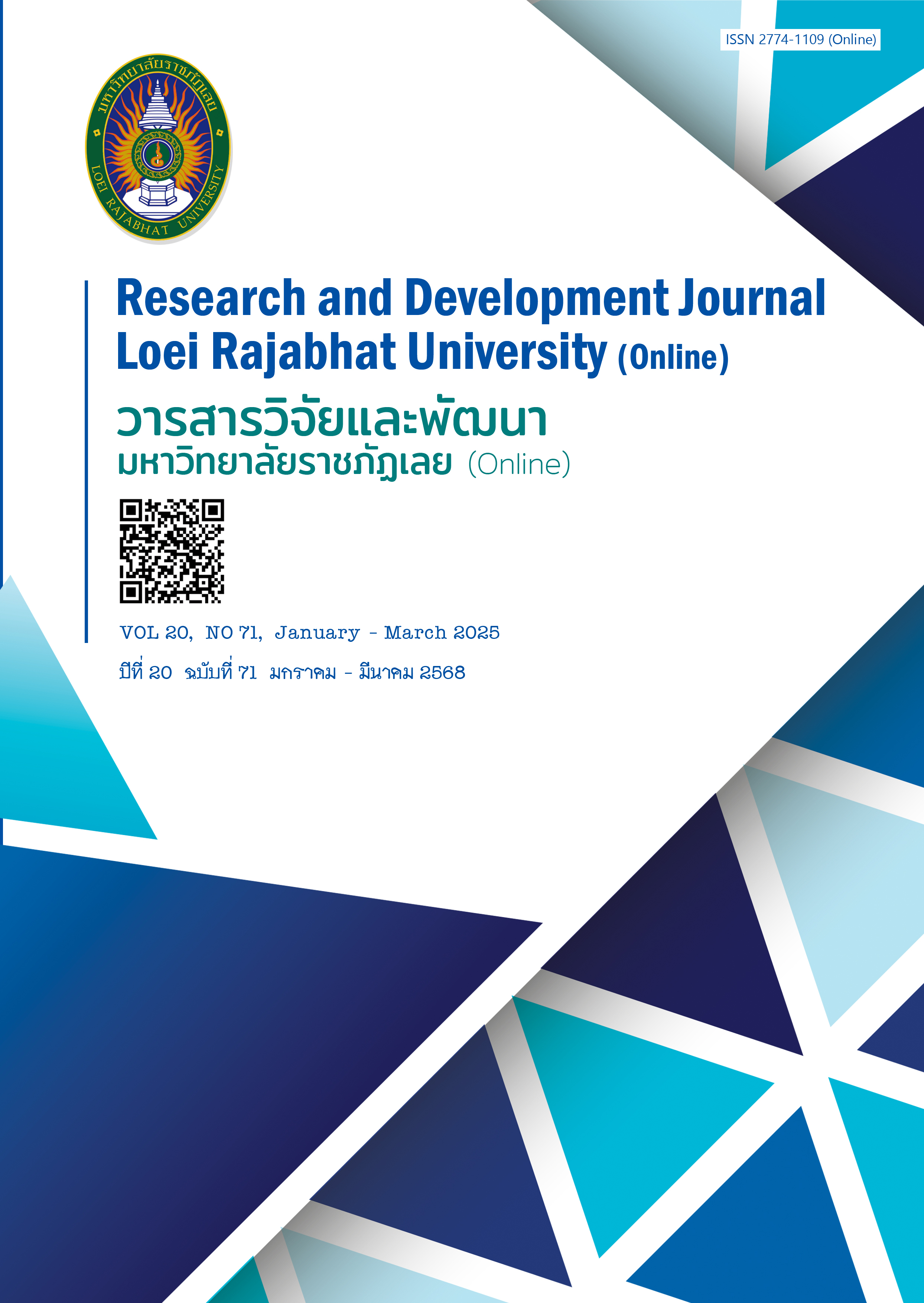Factors Affecting Intention to Use Electronic Saraban Technology: A Case Study of the Dairy Farming Promotion Organization of Thailand
Keywords:
behavioral intention, technology, Electronic SarabanAbstract
This study aimed to: 1) investigate the factors influencing the intention to use Electronic Saraban Technology; and 2) test the influence of these factors on the intention to use Electronic Saraban Technology. The population of this study consisted of clerical staff and those involved in the electronic document management system of each department within the five branches of the Thai Dairy Promotion Organization. The total population was 158 individuals from 78 departments. A questionnaire was designed based on A Model of Unified Technology Acceptance and use of Technology: UTAUT to collect data on the factors affection intention to use Electronic Saraban Technology among the personnel of the Thai Dairy Promotion Organization.Data were analyzed using statistical software to perform descriptive statistics such as frequency, percentage, mean, and standard deviation, as well as inferential statistics, including multiple regression analysis.The results revealed that: 1) most of the population were female, aged 41-50 years or older, held positions from levels 1-5, and were primarily affiliated with the Central Thai Dairy Promotion Office. They had more than 11 years of work experience; 2) The factors that significantly influenced the intention to use Electronic Saraban Technology were perceived usefulness and ease of use. Factors that did not significantly influence the intention to use Electronic Saraban Technology among the personnel of the Thai Dairy Promotion Organization included gender, age, experience, perceived effort, and social influence.
References
กรรณิการ์ คงทอง. (2561). ความตั้งใจเชิงพฤติกรรมในการใช้เทคโนโลยีของกลุ่มเจเนอเรชั่นเบบี้บูมเมอร์และเจเนอเรชั่นเอ็กซ์ (วิทยานิพนธ์ปริญญามหาบัณฑิต). มหาวิทยาลัยเทคโนโลยีราชมงคลกรุงเทพ, กรุงเทพฯ.
กรัณฑรัตน์ รังสิยารมณ์. (2560). ปัจจัยที่มีผลต่อการยอมรับแอปพลิเคชัน SCB EASY กรณีศึกษาผู้ใช้บริการธนาคารไทยพาณิชย์ (การค้นคว้าอิสระปริญญามหาบัณฑิต). มหาวิทยาลัยธรรมศาสตร์, กรุงเทพฯ.
กัมรภัทร์ เนื้อนวล. (2561). ปัจจัยที่ส่งผลต่อพฤติกรรมการใช้บริการระบบการเช็คอินผู้โดยสารด้วยตนเองอัตโนมัติ กรณีศึกษาท่าอากาศยานนานาชาติสุวรรณภูมิ (วิทยานิพนธ์ปริญญามหาบัณฑิต). มหาวิทยาลัยธรรมศาสตร์, กรุงเทพฯ.
ชรินทร์ เขียวรัตนา. (2563). ปัจจัยการยอมรับเทคโนโลยีที่มีอิทธิพลต่อการตัดสินใจใช้บริการ QRCode ผ่านสมาร์ทโฟน กรณีศึกษา ลูกค้าธนาคารกรุงเทพ จำกัด (มหาชน) ในเขตอำเภอหาดใหญ่จังหวัดสงขลา (สารนิพนธ์ปริญญามหาบัณฑิต). มหาวิทยาลัยสงขลานครินทร์, สงขลา
ฐิติภรณ์ เสาร์คํา. (2558). ระดับการยอมรับระบบสารบรรณอิเล็กทรอนิกส์ของผู้ใช้ในมหาวิทยาลัยเชียงใหม่ (การค้นคว้าอิสระปริญญามหาบัณฑิต). มหาวิทยาลัยเชียงใหม่, เชียงใหม่.
ธาดาธิเบศร์ ภูทอง และ นัทธมน มั่งสูงเนิน. (2560). ปัจจัยที่มีอิทธิพลต่อความตั้งใจในการยอมรับบริการสุขภาพผ่านโทรศัพท์เคลื่อนที่ของผู้สูงอายุ (สารนิพนธ์ปริญญามหาบัณฑิต). มหาวิทยาลัยศิลปากร, กรุงเทพฯ
วรนนท์ ชนะ. (2565). ปัจจัยที่มีอิทธิพลต่อความตั้งใจใช้บริการระบบจําหน่ายตั๋วโดยสารอิเล็กทรอนิกส์ของผู้โดยสารการรถไฟแห่งประเทศไทย (วิทยานิพนธ์ปริญญามหาบัณฑิต). มหาวิทยาลัยธรรมศาสตร์, กรุงเทพฯ.
วีณา พึงวิวัฒน์นิกุล. (2562). การจัดการทรัพยากรมนุษย์ในบริบทอนาคตแรงงานไทยในยุคดิจิทัล. วารสาร มจร. พุทธปัญญาปริทรรศน์, 4(2), 286-296.
สํานักนายกรัฐมนตรี. (2526). ระเบียบสำนักนายกรัฐมนตรีว่าด้วยงานสารบรรณ พ.ศ. 2526. กรุงเทพฯ: กองการพิมพ์
สำนักงานคณะกรรมการนโยบายรัฐวิสาหกิจ กระทรวงการคลัง. (2565ก). ร่างแผนพัฒนารัฐวิสาหกิจ พ.ศ. 2566-2570, กรุงเทพฯ: สำนักงานคณะกรรมการนโยบายรัฐวิสาหกิจ กระทรวงการคลัง.
สำนักงานคณะกรรมการนโยบายรัฐวิสาหกิจ กระทรวงการคลัง. (2565ข). แผนเเม่บทการบริหารทุนมนุษย์เเละแผนปฏิบัติการ 2566, กรุงเทพฯ: สำนักงานคณะกรรมการนโยบายรัฐวิสาหกิจ กระทรวงการคลัง.
สำนักงานพัฒนารัฐบาลดิจิทัล (องค์การมหาชน). (2564). AI เทคโนโลยีปัญญาประดิษฐ์. สืบค้นจาก https://www.dga.or.th/th/profile/2157/
สุวิชญา สุริยมงคล และ กวิน ตันติเสวี. (2563). ปัจจัยที่มีผลต่อการยอมรับและการใช้แบบจําลองสารสนเทศอาคาร (BIM) ในหน่วยงานภาครัฐ กรณีศึกษา: หน่วยงานยุทธโยธา สังกัดกระทรวงกลาโหม. การประชุมวิชาการวิศวกรรมโยธาแห่งชาติ ครั้งที่ 25 (น. 413-421). ชลบุรี: มหาวิทยาลัยเทคโนโลยีพระจอมเกล้าพระนครเหนือ.
สุศิภรณ์ อุดมสุข. (2563). ปัจจัยที่มีผลต่อการยอมรับและการตัดสินใจใช้เทคโนโลยี Kiosk สำหรับการเช็คสิทธิ์อัตโนมัติด้วยตนเอง มาใช้ลีน (Lean) กับภาคบริการในโรงพยาบาลสมเด็จพระนางเจ้าสิริกิติ์ (วิทยานิพนธ์ปริญญามหาบัณฑิต). มหาวิทยาลัยธรรมศาสตร์, กรุงเทพฯ.
อโรชา ตะโกอินทร์. (2563). ส่วนขยายทฤษฎีรวมการยอมรับการใช้เทคโนโลยี (UTAUT2) กับความตั้งใจใช้เครื่องใช้ไฟฟ้าประเภท Internet of Things ในกลุ่มผู้สูงอายุ (การค้นคว้าอิสระปริญญามหาบัณฑิต). มหาวิทยาลัยธรรมศาสตร์, กรุงเทพฯ
Bersin, J., Pelster, B., Schwartz, J., and Van Der Vyver, B. (2017). Introduction: Rewriting the rules for the digital age. Retrieved from https://www2.deloitte.com.
Jennings, J. D. (2016). The Effects of Generational Differences on Conflict Management (Dissertation of Doctor of Philosophy) Capella university, Minneapolis, USA.
Venkatesh, V., Morris, M., and Davis, G. B. (2003). User acceptance of information technology: Toward a unified view. MIS Quarterly, 27(3), 425-478.
Zikmund, W. G., Carr, J. C., and Griffin, M. (2013). Business Research Methods, 9, 1-696. Retrieved from https://drive.google.com/
Downloads
Published
How to Cite
Issue
Section
License
Copyright (c) 2025 Research and Development Journal, Loei Rajabhat University

This work is licensed under a Creative Commons Attribution-NonCommercial-NoDerivatives 4.0 International License.
ข้อความที่ปรากฎในวารสารฉบับนี้เป็นความคิดเห็นของผู้เขียนแต่ละท่าน สถาบันวิจัยและพัฒนา มหาวิทยาลัยราชภัฏเลย และกองบรรณาธิการ ไม่จำเป็นต้องเห็นด้วยและไม่มีส่วนรับผิดชอบใดๆ
สถาบันวิจัยและพัฒนา มหาวิทยาลัยราชภัฏเลย ขอให้ผู้อ่านอ้างอิงในกรณีที่ท่านคัดลอกเนื้อหาบทความในวารสารฉบับนี้





